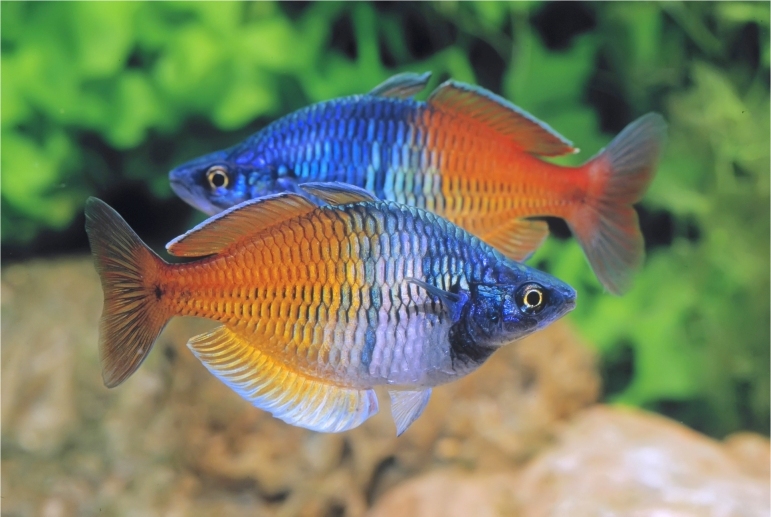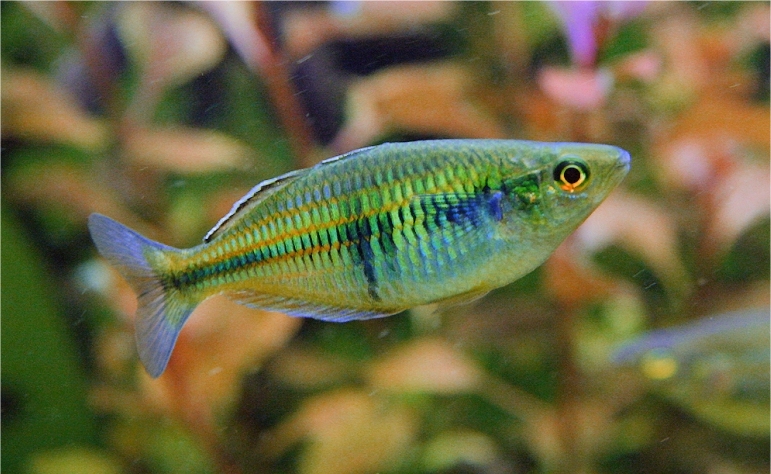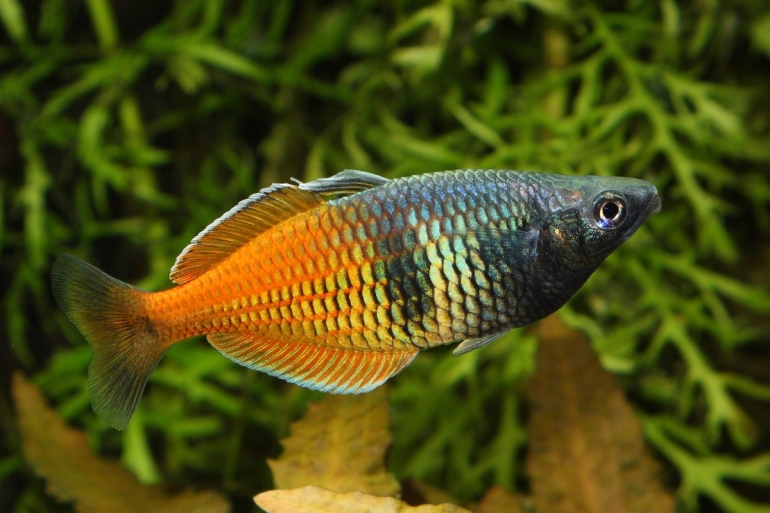|
 |
Melanotaenia boesemani - photo© Gunther Schmida |
Allen and Cross, 1980
Boeseman's Rainbowfish
Species Summary
The colour pattern of male Melanotaenia boesemani is completely different from most other rainbowfishes and show a half-and-half colouration when fully matured. The head and front portion of the body are a brilliant bluish-grey, sometimes almost blackish, with the fins and posterior half of the body largely bright orange-red. Between these two areas, or roughly just behind the pectoral fin, there are alternating light and dark vertical bars. Their wild colouration can fade somewhat in captivity, possibly due to something lacking in the diet, or from the nature of captivity itself. They may reach a maximum size of 12 cm, but are usually less than 10 cm.
Males are easily distinguished from females by their different colour and longer and more elongated dorsal fin rays, and are usually much deeper bodied than females. Females display a broad dark mid-lateral stripe accompanied by a series of narrow yellow or reddish-orange longitudinal stripes corresponding with each scale row that deepen or lighten according to mood. Mature, older females often show colouration similar to subordinate males, but are usually easily identified by a shallower body/chest depth and smaller, more rounded fin edges. Melanotaenia boesemani was named in honour of Dr. Marinus Boeseman, the collector of the type specimens.
The interesting thing about M. boesemani is their remarkable similarity to M. ajamaruensis. However, while M. boesemani and M. ajamaruensis possess a similar colouration and general shape, the stripes on the sides tend to be more pronounced in M. ajamaruensis, particularly the mid-lateral one and the stripe just below it. Melanotaenia boesemani is readily separable from M. ajamaruensis on the basis of soft ray counts for the second dorsal and anal fins. The former species has 10 to 14 (usually 12 or 13) dorsal rays and 17 to 23 (usually 18 to 21) anal rays compared with 15 to 19 (usually 15 to 17) and 21 to 27 (usually 22 to 24) for M. ajamaruensis. Melanotaenia ajamaruensis further differs from M. boesemani by being more slender, and by having the first dorsal fin origin in front (by about one half eye diameter) of the anal fin origin compared to the approximately even position of these fins in M. boesemani.
 |
Melanotaenia boesemani [Lake Aitinjo female] - photo© Joël Felix |
Distribution & Habitat
Melanotaenia boesemani have been mainly collected in Lake Ajamaru and a few surrounding tributaries, but have also been reported from Lake Hain, Lake Aitinjo and Lake Uter. The Ajamaru Lakes region is located about 120 km east-southeast of Sorong, at the headwaters of the Ajamaru River in a mountainous region of the Vogelkop Peninsula, West Papua. The region contains a number of small freshwater lakes and associated marshes. The largest lake, Lake Ajamaru drains east via Lake Hain (comprising two smaller lakes) into the Ajamaru River, an upper tributary of the Kais River that eventually flows into the Ceram Sea to the south.
The Ajamaru lakes are surrounded by a low marshy plain of varying width and, beyond the plain, by hills and mountains reaching heights up to about 1500 metres, covered with forest. Several small streams enter the lakes which have an altitude of about 250 metres above sea level, a depth of rarely more than 3 metres; clear water almost stagnant except near entering rivers and outlets, pH approximately 6.4; a soft muddy bottom mostly covered with a rich aquatic vegetation, while the low shores and coastal plains are usually covered with secondary vegetation consisting primarily of grasses and low shrubs (Boeseman, 1963). Lake Ayamaru has an area of approximately 22 km² and variable depths. In the wetter months (April-June) the lake can rise by up to 5 metres from its dry season level; it never dries out completely, but the shoreline recedes several hundred metres. The lakes and streams have a pH of 6.4-7.8 (de Vries, 1962) and temperate 26-27°C. Heiko Bleher reported the water conditions as pH 9.0, hardness 5° dGH, and conductivity 145 mS/cm. When Marinus Boeseman collected his specimens, he reported a pH of 6.4-6.5.
The lakes are positioned centrally on the Ayamaru Plateau, a heavily karstified region. The average elevation of the plateau is reported as 350 metres above sea level. The Ayamaru Plateau extends for 20-30 km to the south and south-west of the lakes before giving way to a broad zone of relict alluvial landforms dissected by wide flooded river valleys. Fifty kilometres to the east, a mountain block with isolated peaks above 2000 metres altitude flanks the plateau. More distant are the Tamrau Mountains, 65 km to the north, and the Arfak Mountains, more than 100 km to the northeast, both with substantial areas above 2000 metres.
In August 1959, G.A. Reeskamp surveyed the lakes with the objective of determining the potential fisheries of the lakes. He reported that the lakes were shallow and interconnected by channels that might perhaps be better termed as "broads". The three lakes average approximately 2.13 metres in depth and drain in an easterly direction. During the rainy season the water level rises to approximately 2.74 metres and at the dry season large areas of these broads become dry. The greatest depth was found close to the southern margin of the lakes where a basin about 18.28 metres diameter was discovered with a depth of approximately 6.09 metres. The outstanding characteristic of the lakes was the clearness of the water. Owing to the clarity of the water there is complete light penetration to the bottom with the resultant abundant bottom flora of aquatic plants. The pH of the water determined by Bromothymol-blue was recorded as 7.8.
Lake Aitinjo consists of two oddly-shaped parts connected by a short, fast-flowing stream, with considerable rapids and small waterfalls. At the south-eastern end the lake abruptly stops. The effluence is believed to be a subterranean connection, probably over a considerable distance to the Kais River. The southern part especially shows a completely different aspect in comparison with the Ajamaru Lakes. The latter are shallow and surrounded by marshy shores, while Lake Aitinjo has a highly variable depth (to 15-20 metres according to local information) and is surrounded mostly by steep, high, rocky shores, especially along the southern part. The bottom is rocky, at most places covered with sand, stones or large rocks, but muddy at some places. Both the aquatic and terrestrial vegetation are dense, at least where the stony substratum allows growth (Boeseman, 1956; 1963). Lake Uter is a very small lake situated at the headwaters of Lake Aitinjo.
1.jpg) |
Melanotaenia boesemani [Lake Uter] - photo© Laurent Pouyaud |
Remarks
Melanotaenia boesemani were originally collected from Lake Aitinjo by Sten Bergman during the Swedish New Guinea Expedition 1948-1949. Specimens are maintained in the Swedish Museum of Natural History.
Allen & Cross (1980) described M. boesemani from museum specimens reported to have been collected by Marinus Boeseman in March 1955 from the vicinity of Ajamaroe (Ajamaru) on Jow Lake, in the interior of the Vogelkop Peninsula, Netherlands New Guinea. Specimens were also collected from Jate Lake near Djitmau, about 14 km S.E. of Ajamaru and Aitinjo Lake, 25 km S.E. of Ajamaru. Boeseman (1956; 1963) gave a description and map of these localities. Ajamaru (or Jow) Lake is 7 km long and 2 km wide. It is surrounded by a marshy plain and is very shallow (depth rarely more than 3 m). The water is clear, almost stagnant, except near the entrance and the exit of the Ajamaru River, pH is 6.4. The bottom consists of soft mud and is covered by a rich aquatic vegetation. Along the shores the vegetation consists mostly of grasses and low shrubs. The Ajamaru River forms part of the basin of the Kais River, which empties on the south coast of the Vogelkop Peninsula.
Jate Lake near Djitmau, about 14 km S.E. of Ajamaru. This lake lies to the east of Ajamaru Lake and is connected with it by the Ajamaru River, of which both lakes can be considered to be only widened parts. Jate Lake is 3 km long and less than 1 km wide. It lies at a slightly lower altitude than Ajamaru Lake. It is of the same type as Ajamaru Lake.
Aitinjo on Aitinjo Lake, 25 km S.E. of Ajamaru. Aitinjo Lake also is actually a widened river, and probably forms (through a subterranean connection) part of the Kais River basin. The lake is 4 km long and up to 350 m wide. The shores are steep and rocky in most places, but lower and marshy in others. The depth is said to be about 15 or 20 m, but large shallow parts occur; the water is clear, pH about 6.5, flowing rather strongly only at the narrower parts of the lake, including the upper reaches; the bottom is rocky, at most places covered with sand, stones, or large rocks, but muddy at some places. Both the aquatic and terrestrial vegetation are dense, at least where the stony substratum allows growth.
Other Notes
From October 1954 through to May 1955 Marinus Boeseman took part in a collecting expedition for the 'Rijksmuseum van Natuurlijke Historie' to Netherlands New Guinea (West Papua) with L.D. Brongersma and L.B. Holthuis. His task was to provide a thorough knowledge of the fish fauna by intensively surveying as many rivers and lakes as possible in western New Guinea. This task was taken to heart and in a relatively short period many localities were visited, resulting in a rich collection for the museum in Leiden. Among the places he visited was Lake Sentani, Tami River, Biak Island, Lake Jamoer (Yamur), Wissel Lakes, Ajamaroe (Ayamaru) Lakes, Lake Aitinjo (Aytinjo), Merauke and the Digul River. This collection included many rainbowfishes, but a thorough study of this material and descriptions of all the new species was never made by Boeseman. As part of his preparation for the revision of the rainbowfish family, Gerald Allen studied the Dutch collection of 1954-55 during 1975 and 1977. He discovered no less than four new rainbowfish species, which he described in 1980 together with Norbert Cross. These species were Melanotaenia boesemani, M. ajamaruensis, M. japenensis and Glossolepis pseudoincisus.
In November 1982, Gerald Allen had the opportunity to collect live specimens during a visit to the remote Ajamaru Lakes region. Heiko Bleher, a well-known aquarium fish collector, had accompanied Gerald Allen on the trip and was able to transport a number of live specimens captured during the expedition back to Europe, whereupon they were subsequently bred and distributed in the aquarium hobby. Some live specimens were also sent to Australia. In 1998, Heiko Bleher collected more live specimens of M. boesemani from Lake Aitinjo and they too, have been distributed in the aquarium hobby. In 2013 Hans-Georg Evers and Jeffrey Christian collected live specimens of a small form (5-6 cm) of M. boesemani from the Kromsa River near the village of Yokase. The Kromsa River is thought to have a direct connection to Lake Ajamaru.
In 2007-2008, a number of surveys were conducted by the Papuan National Marine and Fisheries Research, the Academy of Fishery Sorong, and the Institute of Research for Development of France in five bioregions of West Papua. During these surveys M. boesemani were collected from a small 3-4 metre wide tributary of Tiwit Creek, less than 1 km north of Lake Ayamaru. The water was clear and slow-flowing over gravel and boulders with patchy vegetation. Water condition reported were: Temperature 24.8°C; pH 7.24 and conductivity 252 µS/cm.
 |
Melanotaenia boesemani [Lake Aitinjo] - photo© Dirk Godlinski |
Literature
Allen G.R. and N.J. Cross (1980) Description of Five New Rainbowfishes (Melanotaeniidae) from New Guinea. Records of the Western Australian Museum 8(3): 377-96.
Allen G.R. & M. Boeseman (1982) A collection of freshwater fishes from western New Guinea with descriptions of two new species (Gobiidae and Eleotridae). Records of the Western Australian Museum 10(2): 67-103.
Allen G.R. (1984) Boeseman's Rainbowfish - The Pearl of Irian Jaya. Tropical Fish Hobbyist 32(6): 22-24.
Boeseman M. (1956) The Lake Resources of Netherlands New Guinea. South Pacific Commission Quarterly Bulletin 6(1): 23-25.
Boeseman M. (1956) Fresh-water sawfishes and sharks in Netherlands New Guinea. Science 123: 222-223.
Boeseman M. (1963) Notes on the fishes of Western New Guinea. Zoologische Mededelingen Leiden 38 (14): 221-242.
de Vries J. (1962) Review of Inland Fisheries in Netherlands New Guinea. South Pacific Commission Fisheries Technical Meeting (Noumea, 5 - 13 February 1962).
Evers H. (2014) Boeseman's Rainbowfish and its rare new cousin. AMAZONAS 3(5): 42-51 [English edition].
Holthuis L.B. (1956) Native fisheries of freshwater Crustacea in Netherlands New Guinea. Contributions to New Guinea Carcinology. I. - Nova Guinea (n. ser.) 7(2): 123-137.
Kadarusman, Sudaro and Laurent Pouyaud (2007) Laporan Expedisi Ilmiah Rainbowfish Papua 2007
10 Mei - 14 Juni. IRD Indonesia.
Reeskamp G.A. (1961) Report of a Preliminary Survey of the Ajamaroe Lakes, Netherlands New Guinea. Indo-Pacific Fisheries Council - Occasional Paper 61/12. Food and Agricultural Organization of the United Nations.
Adrian R. Tappin
Updated February, 2016



|
|

